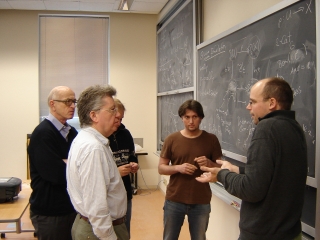
Charbonneau et al. have detected a planet just six and a half times as massive as Earth - at a distance so close its atmosphere could be studied, and with a density so low it's almost certain to have abundant water.
The alien world known as GJ 1214b orbits a red dwarf star one-fifth the size of our own sun, 40 light-years away in the constellation Ophiuchus, the astronomers reported in Thursday's issue of the journal Nature.
arXiv:0912.3229v1 [astro-ph.EP]
Abstract:
A decade ago, the detection of the first transiting extrasolar planet provided a direct constraint on its composition and opened the door to spectroscopic investigations of extrasolar planetary atmospheres. As such characterization studies are feasible only for transiting systems that are both nearby and for which the planet-to-star radius ratio is relatively large, nearby small stars have been surveyed intensively. Doppler studies and microlensing have uncovered a population of planets with minimum masses of 1.9-10 times the Earth's mass (M_Earth), called super-Earths. The first constraint on the bulk composition of this novel class of planets was afforded by CoRoT-7b, but the distance and size of its star preclude atmospheric studies in the foreseeable future. Here we report observations of the transiting planet GJ 1214b, which has a mass of 6.55 M_Earth and a radius 2.68 times Earth's radius (R_Earth), indicating that it is intermediate in stature between Earth and the ice giants of the Solar System. We find that the planetary mass and radius are consistent with a composition of primarily water enshrouded by a hydrogen-helium envelope that is only 0.05% of the mass of the planet. The atmosphere is probably escaping hydrodynamically, indicating that it has undergone significant evolution during its history. As the star is small and only 13 parsecs away, the planetary atmosphere is amenable to study with current observatories.



















